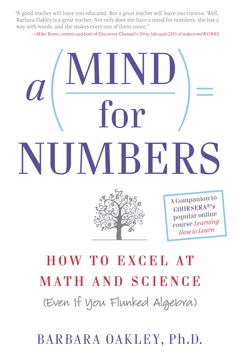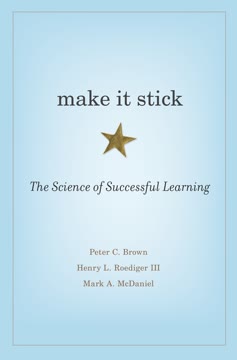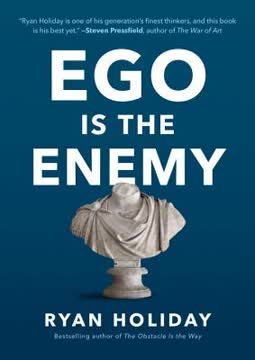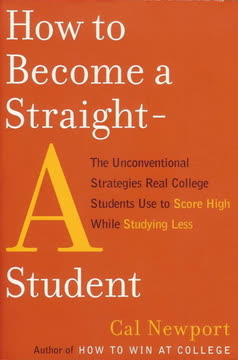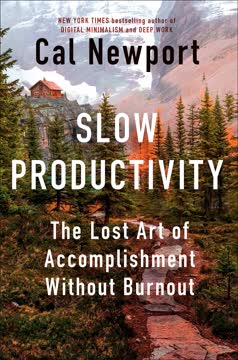النقاط الرئيسية
1. اتقن إدارة الوقت من خلال نظام بسيط يستغرق خمس دقائق يوميًا
قم بتدوين المهام الجديدة والتكليفات خلال اليوم على قائمتك؛ وفي صباح اليوم التالي، انقل هذه المهام إلى جدولك الزمني؛ ثم خصص بضع دقائق لتخطيط يومك.
نظام الخمس دقائق. يعتمد هذا الأسلوب على استخدام التقويم وقائمة يومية. في كل صباح، اقضِ بضع دقائق في نقل المهام من قائمتك إلى التقويم، ثم خطط ليومك بشكل واقعي. يساعدك هذا النظام على:
- متابعة جميع المهام والمواعيد النهائية في مكان واحد
- تجنب المبالغة في تقدير وقت الفراغ المتاح
- الحفاظ على رؤية واضحة لالتزاماتك
بتخصيص خمس دقائق فقط يوميًا لتنظيم جدولك، يمكنك تقليل التوتر وزيادة الإنتاجية بشكل ملحوظ. السر يكمن في الاستمرارية وتكييف النظام بما يتناسب مع احتياجاتك وأسلوب حياتك.
2. تغلب على التسويف من خلال استراتيجيات مستهدفة والوعي الذاتي
خطة مواجهة التسويف رقم 1: احتفظ بمذكرة تقدم العمل
حارب التسويف بفعالية. طبق هذه الاستراتيجيات لتتغلب على الرغبة في تأجيل المهام:
- احتفظ بمذكرة تقدم العمل لتحاسب نفسك
- غذِّ دماغك بالتغذية السليمة والترطيب المناسب
- حوّل المهام الصعبة إلى أحداث لتحفيز نفسك
- أنشئ روتين عمل للحفاظ على تقدم مستمر
- اختر أيامك الصعبة مسبقًا لتقليل تأثيرها
بإدراك أن الرغبة في التسويف أمر طبيعي، يمكنك التركيز على تطوير استراتيجيات للتعامل معها بدلاً من محاولة القضاء عليها تمامًا. المفتاح هو إيجاد الطرق التي تناسبك وتطبيقها باستمرار.
3. حسّن بيئة الدراسة ومدة الجلسات لتحقيق أفضل أداء
حدد عدة أماكن دراسة معزولة منتشرة في الحرم الجامعي وبدّل بينها أثناء الدراسة.
اصنع ظروف دراسة مثالية. لتعزيز إنتاجيتك وتركيزك:
- اختر أماكن هادئة ومعزولة للدراسة
- بدّل بين أماكن الدراسة المختلفة للحفاظ على التحفيز
- حدد مدة جلسات الدراسة بحوالي ساعة تليها استراحات قصيرة
- خصص أصعب المهام لأوقات ذروة طاقتك
باختيار الوقت والمكان والمدة المناسبة للدراسة بعناية، يمكنك تحسين تركيزك واستيعابك للمادة بشكل كبير. تذكر أن الظروف المثلى تختلف من شخص لآخر، لذا جرب حتى تجد ما يناسبك.
4. دوّن ملاحظات استراتيجية لالتقاط المفاهيم الرئيسية بكفاءة
في المواد غير التقنية، سجّل الأفكار الكبرى باستخدام صيغة السؤال/الدليل/الاستنتاج.
طوّر استراتيجيات فعالة لتدوين الملاحظات. عدّل أسلوبك حسب نوع المادة:
في المواد غير التقنية:
- استخدم صيغة السؤال/الدليل/الاستنتاج
- ركز على التقاط الأفكار الكبرى بدلًا من التفاصيل الدقيقة
- استعن بالتنسيق لتسليط الضوء على النقاط المهمة
في المواد التقنية:
- سجّل أكبر عدد ممكن من الأمثلة والحلول
- أعطِ الأولوية لبيان المشكلة والحلول بدلًا من الخطوات الوسيطة
- اطرح أسئلة عند الالتباس وضع علامات على النقاط غير الواضحة للمراجعة لاحقًا
باتباع هذه الاستراتيجيات، ستنشئ ملاحظات أكثر فائدة وتنظيمًا، مما يقلل من وقت الدراسة لاحقًا بشكل كبير.
5. أولويات المهام والقراءات بناءً على الأهمية
قراءة كل المواد في الجامعة رفاهية لا يستطيع معظمنا تحملها، خاصة إذا كنت مشغولًا بالأنشطة اللامنهجية.
نظّم عبء عملك بذكاء. للتعامل مع حجم المهام بكفاءة:
- حدّد وركّز على "المصادر المفضلة" التي تقدم المعلومات الأساسية
- استخدم ترتيب الأهمية للقراءات التكميلية:
- القراءات التي تقدم حججًا
- القراءات التي تصف أحداثًا أو أشخاصًا
- القراءات التي تقدم سياقًا فقط
- دوّن ملاحظات ذكية على القراءات المفضلة باستخدام صيغة السؤال/الدليل/الاستنتاج
- في مجموعات المسائل، اعمل باستمرار وتعاون مع زملائك عند السماح بذلك
بترتيب أولوياتك والتركيز على المواد الأهم، يمكنك الحفاظ على درجات جيدة دون التضحية بحياتك الاجتماعية أو أنشطتك اللامنهجية.
6. استعد للامتحانات باستخدام طريقة الاختبار والاستدعاء
إذا استطعت إغلاق عينيك وشرح حجة من الصفر، أو النظر إلى ورقة بيضاء وإعادة حل مسألة دون خطأ، فهذا يعني أنك استوعبت المفهوم تمامًا.
أتقن طريقة الاختبار والاستدعاء. تعتمد هذه التقنية الدراسية الفعالة على:
- إنشاء اختبارات تدريبية من ملاحظاتك ومواد الدراسة
- محاولة الإجابة على كل سؤال شفهيًا أو كتابيًا
- مراجعة وتصحيح إجاباتك
- تكرار العملية مع التركيز على النقاط الصعبة
في المواد التقنية:
- حل مسائل نموذجية وشرح المفاهيم بصوت عالٍ
- استخدم الامتحانات التدريبية عند توفرها
تضمن هذه الطريقة تفاعلًا نشطًا مع المادة وتساعد في تحديد النقاط التي تحتاج إلى مزيد من التركيز. هي أكثر فاعلية من المراجعة السلبية وتساعدك على ترسيخ المفاهيم بعمق.
7. اكتب أوراقًا متميزة بتقسيم العملية إلى خطوات قابلة للإدارة
شكوى شائعة أسمعها من الطلاب هي أنهم لا يجدون وقتًا كافيًا لإنهاء كل أعمالهم.
تعامل مع كتابة الأوراق بشكل منهجي. قسم العملية إلى الخطوات التالية:
- اختر موضوعًا مثيرًا ضمن معايير التكليف
- طور فرضية محددة من خلال البحث الأولي
- اطلب ملاحظات على فرضيتك من أستاذك
- أجرِ بحثًا شاملاً ومنظمًا
- أنشئ مخططًا تفصيليًا لحجتك
- احصل على ملاحظات على المخطط من الزملاء والأساتذة
- اكتب ورقتك مع التركيز على وضوح عرض الحجة
- حرر عملك بعناية
بتقسيم هذه المكونات، تجعل عملية كتابة الورقة أقل إرهاقًا وأكثر كفاءة. هذا الأسلوب يسمح لك بالتركيز على كل جانب على حدة، مما يؤدي إلى منتج نهائي عالي الجودة.
8. حرر أوراقك بفعالية دون الانشغال بالكمال
يمكنك تحرير ورقة إلى الأبد دون أن ترضى عنها. لذا من المهم أن تعرف متى تطبعها وترسلها إلى مصيرها.
طبق نظام تحرير من ثلاث مراحل. لتحسين ورقتك بفعالية دون الإفراط في التحرير:
-
مرحلة تعديل الحجة:
- ركز على عرض وبنية حججك
- أجرِ تعديلات كبيرة لتحسين الوضوح والتدفق
-
مرحلة القراءة بصوت عالٍ:
- اطبع ورقتك واقرأها بصوت مرتفع
- ضع علامات على الأخطاء النحوية والتعابير غير المناسبة
- صحح بناءً على ملاحظاتك
-
مرحلة المراجعة النهائية:
- استعرض نسخة مطبوعة بسرعة للبحث عن أي أخطاء متبقية
- استخدم هذه القراءة النهائية لتختتم عملك
يساعدك هذا النظام على تحقيق توازن بين التحرير الدقيق والاستخدام الفعال للوقت، مما يضمن أن ورقتك مصقولة دون الوقوع في هوس التفاصيل الصغيرة.
آخر تحديث::
FAQ
What's "How to Become a Straight-A Student" about?
- Author and Focus: Written by Cal Newport, the book provides unconventional strategies used by real college students to achieve high grades while studying less.
- Research-Based Advice: The advice is based on interviews with top-scoring undergraduates from prestigious universities, focusing on efficient study habits rather than excessive study hours.
- Practical Techniques: It offers practical techniques for time management, exam preparation, and paper writing, aiming to help students balance academics with social life.
- Target Audience: The book is intended for college students looking to improve their grades without sacrificing their well-being or social activities.
Why should I read "How to Become a Straight-A Student"?
- Efficiency Over Effort: The book emphasizes studying smarter, not harder, which can save time and reduce stress.
- Real-World Examples: It includes strategies from successful students, making the advice relatable and applicable to real college scenarios.
- Comprehensive Approach: Covers various aspects of college life, including time management, exam preparation, and paper writing, providing a holistic approach to academic success.
- Balance and Well-being: Encourages maintaining a balanced lifestyle, ensuring students can enjoy college life while excelling academically.
What are the key takeaways of "How to Become a Straight-A Student"?
- Time Management: Implement a simple, five-minute daily planning system to manage tasks and deadlines effectively.
- Avoid Procrastination: Use specific strategies to combat procrastination, such as keeping a work progress journal and creating routines.
- Study Techniques: Focus on high-intensity, short study sessions rather than long, low-intensity marathons to maximize learning.
- Paper Writing: Break down the paper-writing process into manageable steps, from topic selection to final editing, to reduce stress and improve quality.
What are the best quotes from "How to Become a Straight-A Student" and what do they mean?
- "Efficiency. The simple truth is that the brute force techniques used by most students are incredibly inefficient." This quote highlights the book's core message that smarter study techniques can lead to better results with less effort.
- "Pseudo-work features a very low intensity of focus. Therefore, to accomplish something by pseudo-working, you need to spend a lot of time." It emphasizes the importance of focused, high-intensity study sessions over long, unfocused ones.
- "A little organization goes a hell of a long way." This underscores the book's advocacy for simple, effective time management strategies to reduce stress and improve academic performance.
- "The key to improving your grades without becoming a grind cannot be found in any single study habit." It suggests that success comes from a combination of strategies tailored to individual needs and circumstances.
How does Cal Newport suggest managing time in "How to Become a Straight-A Student"?
- Daily Planning: Spend five minutes each morning updating your calendar and planning your day, focusing on realistic time frames for tasks.
- Task Prioritization: Label tasks with specific time slots to avoid overestimating free time and ensure all obligations are met.
- Flexibility: Allow for adjustments throughout the day to accommodate unexpected events while maintaining productivity.
- Minimal Effort: The system is designed to be lightweight and easy to restart after periods of neglect, making it sustainable for busy students.
What strategies does Cal Newport recommend for avoiding procrastination in "How to Become a Straight-A Student"?
- Work Progress Journal: Keep a daily record of tasks and accomplishments to hold yourself accountable and reduce procrastination.
- Energy Management: Maintain high energy levels by staying hydrated, monitoring caffeine intake, and eating healthy snacks.
- Task Routines: Establish consistent times for specific tasks each week to build productive habits and reduce decision fatigue.
- Hard Days Planning: Schedule intense workdays in advance to manage workload effectively and prevent last-minute stress.
What study techniques are highlighted in "How to Become a Straight-A Student"?
- Quiz-and-Recall Method: Actively recall and articulate concepts in your own words to reinforce learning and improve retention.
- Focused Study Sessions: Limit study periods to one hour with regular breaks to maintain high intensity and avoid fatigue.
- Isolation for Concentration: Choose isolated study spots to minimize distractions and enhance focus during study sessions.
- Efficient Note-Taking: Use a question/evidence/conclusion format for nontechnical courses and prioritize sample problems in technical courses.
How does Cal Newport suggest handling reading assignments in "How to Become a Straight-A Student"?
- Selective Reading: Focus on favored sources and use an importance hierarchy to determine which supplemental readings to skim or skip.
- Efficient Note-Taking: Take notes in a question/evidence/conclusion format to capture big ideas without excessive detail.
- Constant Work: Spread reading assignments over several days to avoid last-minute cramming and improve comprehension.
- Group Work: Collaborate with classmates on problem sets to enhance understanding and reduce individual workload.
What is the "quiz-and-recall" method in "How to Become a Straight-A Student"?
- Active Recall: After reviewing material, try to explain it unaided in your own words to ensure deep understanding and retention.
- Practice Quizzes: Create quizzes from your notes and attempt to answer them without looking, focusing on areas of difficulty.
- Iterative Process: Repeat the quiz-and-recall process until you can answer all questions confidently, minimizing wasted study time.
- Efficiency: This method targets weak areas and reinforces learning, making it more effective than passive review techniques.
How does Cal Newport recommend writing papers in "How to Become a Straight-A Student"?
- Separate Components: Break down the writing process into distinct steps: topic selection, thesis development, research, and writing.
- Detailed Outlines: Create a topic-level outline with supporting quotes to guide writing and ensure a coherent argument.
- Consult Experts: Seek feedback from professors and peers on your outline to refine your argument before writing.
- Efficient Editing: Use a three-pass editing process to polish your paper without fixating on endless revisions.
What is the importance of "academic disaster insurance" in "How to Become a Straight-A Student"?
- Eliminate Uncertainty: Address unclear topics as they arise to prevent gaps in understanding that could lead to exam surprises.
- Proactive Approach: Use class time, office hours, and peer discussions to clarify confusing concepts before exams.
- Minimize Last-Minute Stress: By resolving uncertainties early, you reduce the need for extensive last-minute studying.
- Confidence Boost: Enter exams with a comprehensive understanding of all topics, increasing confidence and performance.
How does "How to Become a Straight-A Student" suggest balancing academics and social life?
- Efficient Study Habits: Implement strategies that reduce study time, freeing up hours for social activities and relaxation.
- Prioritize Well-being: Emphasize the importance of sleep, exercise, and social interactions to maintain mental and physical health.
- Flexible Scheduling: Use a dynamic time management system to accommodate both academic and social commitments.
- Holistic Approach: Recognize that a balanced lifestyle contributes to academic success and overall happiness, as advocated by the book.
مراجعات
يحظى كتاب "كيف تصبح طالبًا متفوقًا" بتقييمات متباينة. إذ يشيد الكثيرون بنصائحه العملية في إدارة الوقت، وتدوين الملاحظات، والاستعداد للامتحانات. كما يقدر القراء الأمثلة الواقعية المستمدة من تجارب طلاب ناجحين، ويجدون أن الاستراتيجيات المقدمة قابلة للتطبيق في مجالات تتجاوز الدراسة الأكاديمية. في المقابل، ينتقد بعضهم الكتاب لكونه قديمًا أو لعدم تناوله المواد التقنية بشكل كافٍ. وبينما وجد كثيرون فيه فائدة لتحسين عادات الدراسة والدرجات، رأى آخرون أن النصائح تبدو بديهية أو غير قابلة للتطبيق على الجميع. وبشكل عام، يُنظر إلى الكتاب على أنه مصدر محتمل للفائدة للطلاب الراغبين في تعزيز أدائهم الأكاديمي.
Similar Books

